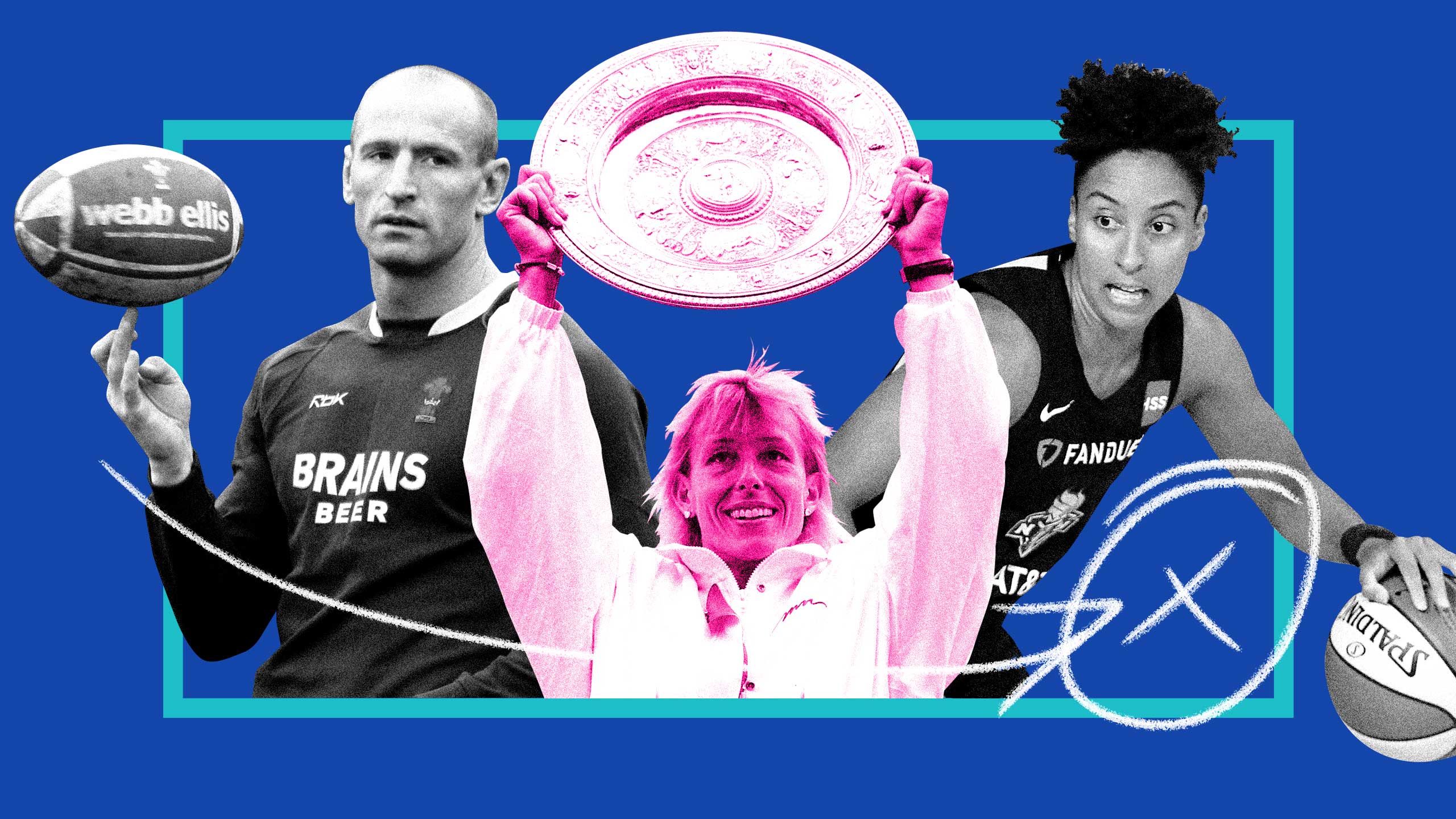When Las Vegas Raiders player Carl Nassib came out as gay last week, an astro-turf ceiling was broken.
With his announcement, where he also pledged $100,000 to the Trevor Project, Nassib became the first openly gay active NFL player in the league’s century of existence. While previous NFL players, like Dave Kopay, came out after retiring from the league or were openly gay but didn’t actively play, like Michael Sam, Nassib will be publicly out when he suits up for this upcoming season.
He follows in the footsteps of dozens of other LGBTQ2S+ athletes who paved the way for progress across the spectrum of sports. And while certain areas like women’s soccer have high-profile involvement of queer athletes and activists today, it wasn’t always that way.
As long as there’s been sport, there have been queer athletes. But it’s because of the bravery and activism of those who came before that players like Nassib can break boundaries of their own.
Here are 12 queer trailblazing athletes who made history (or are still making it) that you should know about.
Tom Waddell (track and field)
A working doctor and military veteran, Waddell placed sixth in the decathlon at the 1968 Olympics in Mexico City. Following an injury at a 1972 track meet, he retired from competition and pivoted to establishing gay sporting events. He came out publicly on the cover of People magazine in 1976. After participating in a gay bowling league, he was inspired to start the “gay Olympics” in San Franscisco in 1982. The International Olympic Committee sued over the name, and the event went forward as the “Gay Games.”
In 1983, motivated by a mutual desire to have kids, he and lesbian athlete Sara Lewinstein had a child together. Waddell was diagnosed with AIDS in 1985, but participated in that year’s Gay Games II, where he won gold in the javelin event. He died in 1987.
John Curry (figure skating)
In 1976, Curry won the European, World and Olympic titles in figure skating. He was the first-ever British skater to win Olympic gold, and carried his country’s flag at the 1976 games. Shortly after his gold, he was outed as a gay man in the press when comments he thought were off the record were published.
Curry died of an AIDS-related heart attack in 1994.
Renée Richards (tennis)
While many trans trailblazers have come out since, Richards was the first high-profile trans athlete to advocate for her right to participate in women’s sports as an openly trans woman. After some success on the tennis circuit, Richards transitioned in 1975. She applied to play in the 1976 U.S. Open as a woman, but was barred from participating for refusing to undergo a chromosome-based “sex test.”
She sued the U.S. Tennis Association alleging gender discrimination, and won. The U.S. Supreme Court ruled that requiring her to pass the test was “grossly unfair, discriminatory and inequitable, and a violation of her rights.”
Richards competed in the 1977 U.S. Open, reaching the doubles final with her partner Betty Ann Grubb Stuart. Her advocacy would later pave the way for trans-inclusive policies across sports.
Billie Jean King (tennis)
Throughout the 1970s, King rose to fame as one of the greatest tennis players in the world and as an advocate for women’s equality both on and off the court. She was outed as a lesbian when a 1981 lawsuit involving former lover Marilyn Barnett became public, making her the highest profile female professional athlete to come out as gay at the time.
King has described the outing as “horrible,” and says she was urged by lawyers and her press representatives to deny it. But King confirmed the relationship publicly. In 1987, she began a relationship with her doubles partner Ilana Kloss, and the two remain together to this day.
King has since become a fierce advocate for LGBTQ2S+ rights. In a 2017 NBC retrospective, she said her only regret was not coming out sooner.
Martina Navratilova (tennis)
King wasn’t the only tennis star to come out as a lesbian in the 1980s. Much like Curry, Czech tennis planner Navratilova was outed by the press, who published an interview that revealed her sexuality and her relationship with Rubyfruit Jungle author Rita Marie Brown. Navratilova and then-girlfriend Nancy Lieberman subsequently gave an interview where she said she was bisexual. Navratilova later came out as a lesbian.
She’s since become a strong advocate for LGBTQ2S+ rights, and received the National Equality Award from the Human Rights Campaign in 2000.
Justin Fashanu (soccer)
Fashanu is widely regarded as the first openly gay professional soccer player in the U.K. When he came out in 1990, he claimed that he was generally well accepted by his teammates, but said he still faced homophobic jokes and jeering from stadium crowds. Despite Fashanu’s track record on the soccer pitch, no club offered him a full-time contract after he came out.
After Fashanu moved to the U.S., he was accused by a 17-year-old of sexual assault. Warrants were released calling for his arrest. Fashanu fled to England where he died by suicide.
Gareth Thomas (rugby)
Welsh rugby player Thomas was one of the most accomplished in his sport when he came out publicly in 2009. In an interview, he told the Daily Mail at the time “I don’t want to be known as a gay rugby player. I am a rugby player, first and foremost. I am a man.”
While he retired from professional rugby in 2011, Thomas has continued to be an LGBTQ2S+ advocate. His autobiography, Proud, won the William Hill Sport Book of the Year award in 2015, and he’s spoken openly about his HIV-positive status since 2019.
Jason Collins (basketball)
Collins came out as gay in a 2013 Sports Illustrated story, making him the first active athlete in one of the four major leagues in North America (NBA, NFL, MLB, NHL) to come out.
“I’m a veteran, and I’ve earned the right to be heard. I’ll lead by example and show that gay players are no different from straight ones,” Collins wrote.
Collins was a free agent when he came out, but signed with the Nets the following year. He chose to wear 98 on the court in honour of Matthew Shepherd, whose 1998 gay bashing and murder shocked the world. Collins’ jersey quickly became the number one selling NBA jersey at the time.
Patricio Manuel (boxing)
After competing successfully on the U.S. amateur women’s boxing circuit until 2012, Manuel transitioned and entered amateur men’s boxing in 2016. He won his professional debut match against Hugo Aguilar in December 2018, becoming the first trans man to box professionally and also the first one to win.
Chris Mosier (duathlon/racewalking)
Mosier began his transition in 2010, and in 2015 was selected by Team USA’s sprint duathlon—a sport involving cycling and running—men’s team for the 2016 World Championship. Mosier challenged existing International Olympic Committee policy regarding trans peoples’ eligibility to participate, leading to the policy being rewritten.
Mosier would go on to compete in duathlon, triathlon and racewalking competitively. In 2020, he competed in the U.S. Olympic trials for racewalking, becoming the first openly trans man to compete in an Olympic trial, but had to withdraw due to injury.
Outside of competition, he’s advocated for trans athletes across the board, working with various LGBTQ2S+ non-profits and founding transathlete.com, a resource for trans sports.
Layshia Clarendon (basketball)
Since coming out as trans and non-binary, WNBA player Clarendon has become a beacon for trans equality and activism in the league.
In a 2015 story for The Players’ Tribune, they identified themself as “not cisgender.” They’ve since spoken openly about living outside the gender binary and using she/her, they/them and he/him pronouns interchangeably.
“Existing outside of the binary for me is freedom. I’ve learned that my gender just doesn’t fit into these molds that keep trying to hold it down and box it in. I know that my gender will keep evolving because we change and grow and shape shift and expand,” they wrote in an Instagram post last year.
They underwent top surgery in early 2021 with support from the league and their teammates.
Laurel Hubbard (weightlifting)
When New Zealand weightlifter Hubbard takes the mat in Tokyo this summer, she’ll be breaking new ground as the first openly trans woman to compete in the Olympic Games. Hubbard has competed in women’s weightlifting for nearly a decade, but the Olympics will be her biggest spotlight yet.
And she won’t be alone. Non-binary Canadian soccer player Quinn has also qualified, and other trans athletes in the Games could be on the horizon. (We’ll return to the subject of LGBTQ2S+ Olympians in a future story.)


 Why you can trust Xtra
Why you can trust Xtra


